IMO 9375654
Built 2008, Aker Yards Helsinki, Finland
Tonnage 35 778 GT
Length 186,71 m
Width 27,70 m
Draugth 6,75 m
Ice class 1A Super
2 500 passengers
732 berths
230 cars
1 000 lanemeters
4 Wärtsilä diesels, combined 40 000 kW
2 propellers
2 bow thrusters
1 stern thruster
Speed 25 knots
It seems the previous Viking XPRS entry with the history of the ship on is somewhat out of date, so it's high time to update.
Viking XPRS was originally a project name for Viking's new fast cruiseferry (XPRS being "short" for express). She was the first newbuilding delivered to Viking Line since 1990 and the first delivered to SF Line (the sole surviving Viking consortium member that renamed itself Viking Line in 1995) since 1989. In the interim the company had drawn up plans for various unrealized newbuildings, including a fast monohull ferry capable of 40 knots for the Helsinki-Tallinn service. Matters leading to the construction of the XPRS started progressing in 2003, when the Cinderella that had been doing 20 hour cruises between Helsinki and Tallinn was moved to a similar service between Stockholm and Mariehamn. In her place the former Stockholm-Mariehamn ship Rosella was moved to Helsinki-Tallinn service, with tro daily departures from each port. After initial difficulties the Rosella's ferry service proved to be a success, and Viking begun planning the addition of a newbuilding for the route.
Viking Line's own designing department drew up the basic plans for project Viking XPRS. After asking for tenders from various shipyards, the company entered serious negotations with Aker Yard's Finnish shipyards and the state-owned Italian shipbuilder Fincantieri. The former offered to build a ship for 130 million euros, while the latter was willing to build a ship based on Viking's plans for 115 million US dollars, or an example of their own Moby Wonder -class (the same design as Tallink's Superstar) for 110 million USD. Despite the higher price asked by Aker Yards, Viking ordered their newbuilding from Aker's Helsinki shipyard. The order included an option for two sister ships, which were planned to be built for the Turku-Stockholm service replacing the Amorella and Isabella. Presumably these ships would have been built with larger superstructures to house more passenger cabins and additional public spaces nescessary for the longer route. In the end Viking never exercised the option for these ships and the XPRS remains a one-off design.
The original delivery date for the Viking XPRS was set for 31 January 2008. Delays in the construction, including faults in the propellers that nescessitated an extra drydocking in Rauma, pushed the delivery date back to 21 April 2008. In summer 2007 Viking Line had organised a naming competition for their new ship. In a somewhat unusual move, the result of the competition was that Viking XPRS was chosen as the final name of the ship. (The author of this blog also participated in the competition, suggesting the more traditionally-tinted "Laurella").
Following delivery the Viking XPRS was initially registered in Mariehamn, Finland. However, this was little more than ceremony as the decision had already been made to register the ship in Sweden due to financial reasons. After spending a whole day under Finnish flag the Viking XPRS was re-registered to Norrtälje in Sweden. She entered regular service on the Helsinki-Tallinn service on 28 April 2008, replacing the Rosella (originally Viking had hoped to employ both ships on the route, but the city of Helsinki forbade this as they did not want additional cars passing through the city center).
Although the Viking XPRS was a resounding success during her first summer, with 61% increase in passenger numbers and 74% in freight, her interiors were found to be too small for the number of passengers carried. Resultingly a new dance pavillion was added to the rear decks in spring 2009. Afterwards, the ship settled nicely on the Helsinki-Tallinn route, becoming the most popular ship on the line. In early 2014, she was moved under the Estonian flag to further save costs. In January 2017, the Dance Pavillion added in 2009 was rebuilt in a larger form; interior photos of the ship as she appears today can be seen here.
The photos below show the Viking XPRS departing Helsinki Eteläsatama (South Harbour) for Tallinn around noon on 19 May 2017, photographed from Valkosaari. As always, click on the images to see them in larger size.
 |
| Valkosaari gives nice foregrounds. I ought to go there more often. |

















